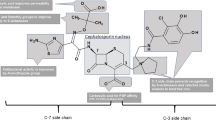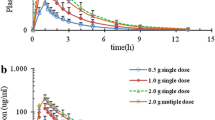Summary
The therapeutic efficacy and pharmacokinetics of the cephalosporins ceftazidime, ceftizoxime, cefotaxime and HR 221 were studied in animal experiments. The animal model used was experimental estrogen-induced or non-induced chronicEscherichia coli pyelonephritis in rats. The animals were treated with 5 mg cephalosporin/kg twice daily for one week. Each of the cephalosporins tested led to a significant decrease in renal bacterial counts, in spite of the low doses given. Ceftazidime was significantly more active than HR 221 in both experimental models, although the serum levels of HR 221 were higher and were maintained for a longer period of time than those of ceftazidime. Differences in pharmacokinetic properties (influenced by metabolic stability and protein binding) could be the reason for the differences in therapeutic activity, since thein vitro antimicrobial activity of each of the cephalosporins tested was very similar against the test strain.
Zusammenfassung
Die therapeutische Effektivität und Pharmakokinetik der Cephalosporine Ceftazidim, Ceftizoxim, Cefotaxim und HR 221 wurde tierexperimentell untersucht. Tiermodell war die experimentelle östrogengebahnte und nicht-gebahnte chronischeE. coli-Pyelonephritis der Ratte. Die Tiere wurden für eine Woche 2× täglich mit 5 mg Cephalosporin/kg behandelt. Alle Cephalosporine führten zu einem signifikanten Abfall der renalen Keimzahlen trotz der niedrigen Dosierung. In beiden Tiermodellen war Ceftazidim signifikant wirksamer als HR 221, obwohl die Serumspiegel von HR 221 höher waren und länger andauerten als die von Ceftazidim. Unterschiede in der Pharmakokinetik (metabolische Stabilität, Proteinbindung) könnten der Grund für die unterschiedliche therapeutische Effektivität sein, da die antimikrobielleIn-vitro-Aktivität aller Cephalosporine gegenüber dem Testkeim sehr ähnlich war.
Similar content being viewed by others
Literature
Hamilton-Miller, J. M. T., Brumfitt, W., Reynolds, A. V. Cefotaxime (HR 756), a new cephalosporin with exceptional broad-spectrum activityin vitro. J. Antimicrob. Chemother. 4 (1978) 437–444.
Sosna, J. P., Murray, P. R., Medoff, G. Comparison of thein vitro activities of HR 756 with cephalothin, cefoxitin and cefamandole. Antimicrob. Agents Chemother. 14 (1978) 876–879.
Knothe, H., Dette, G. A. Thein vitro activity of ceftazidime against clinically important pathogens. J. Antimicrob. Chemother. 8 Suppl. B (1981) 33–41.
Bint, A. J., Yeoman, P., Kilburn, P., Anderson, R., Stansfield, E. Thein vitro activity of ceftazidime compared with that of other cephalosporins. J. Antimicrob. Chemother. 8 Suppl. B (1981) 47–51.
Kamimura, T., Matsumoto, Y., Okada, N., Mine, Y., Nishida, M., Goto, S., Kuwahara, S. Ceftizoxime (FK 749) a new parenteral cephalosporin:in vitro andin vivo antibacterial activities. Antimicrob. Agents Chemother. 16 (1979) 540–548.
Investigators' Brochure on HR 221 (1980). Hoechst, West Germany.
Commichau, R., Freiesleben, H., Sack, K., Krüger, Ch., Henkel, W. Model for assessment of activity of antimicrobial agents. In:Williams, J. D., Geddes, E. M. (eds.): Chemotherapy, Vol. 2, Plenum Press, New York 1976, pp. 317–322.
Sachs, L. Angewandte Statistik. Springer Verlag, Berlin 1973.
Ericsson, H. M., Sherris, J. C. Antibiotic sensitivity testing. Report of an international collaborative study. Acta Pathol. Microbiol. Scand. Sect. B Suppl. 217 (1971) 65–67.
Klein, P. Bakteriologische Grundlagen der chemotherapeutischen Laboratoriumspraxis. Springer Verlag, Berlin 1957.
Marre, R., Züllich, B., Beck, H., Sack, K. Tierexperimentelle Untersuchungen über die antibakterielle Aktivität von 10 Cephalosporinen. Zbl. Bakt. Hyg. I, Abt. Orig. A 240 (1978) 529–537.
Bopp, S., Marre, R., Schulz, E., Sack, K. Tierexperimentelle Studien zur Nierenverträglichkeit, Pharmakokinetik und therapeutischen Effektivität von Dibekacin. Arzneim. Forsch. 31 (1) (1981) 473–477.
Investigators' Brochure on HR 756. Hoechst, West Germany.
Harding, S. M., Monro, A. J., Thornton, J. E., Ayrton, J., Hogg, M. I. J. The comparative pharmacokinetics of ceftazidime and cefotaxime in healthy volunteers. J. Antimicrob. Chemother. 8 Suppl. B (1981) 263–272.
Noda, K., Suzuki, A., Ohta, H., Furukawa, T., Noguchi, H. Metabolic fate of (14C)-ceftizoxime, a parenteral cephalosporin antibiotic, in rats and dogs. Arzneim. Forsch. 30 (II) (1980) 1665–1679.
Investigators' Brochure on Ceftizoxime. Fujisawa Pharmaceutical Co., Japan.
Author information
Authors and Affiliations
Rights and permissions
About this article
Cite this article
Marre, R., Herhahn, D., Freiesleben, H. et al. Ceftazidime, ceftizoxime, cefotaxime and HR 221 in experimental chronic Escherichia coli pyelonephritis in rats. Infection 11 (Suppl 1), S54–S56 (1983). https://doi.org/10.1007/BF01641108
Issue Date:
DOI: https://doi.org/10.1007/BF01641108




